 |
THE DEFENDERS
Wellington's combined Anglo-Portuguese army numbered a little over 52,000 men of which almost half were untried Portuguese troops. Such a small body of men could not hope to defend the entire nine miles of mountain in sufficient strength or depth to withstand a sustained attack.
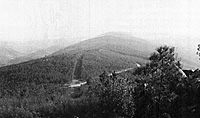 At right, a view toward the San Antonio pass and the far right of the Anglo-Portuguese line. It is easy to see from this view why Massena considered the ridge too extended for Wellington to defend successfully.
At right, a view toward the San Antonio pass and the far right of the Anglo-Portuguese line. It is easy to see from this view why Massena considered the ridge too extended for Wellington to defend successfully.
Yet the great advantage of the position was that because the ground was so steep and difficult to climb every movement of the attackers could be observed from the slopes and the crest of the
ridge allowing the defenders to concentrate on any threatened point. The defenders could also remain concealed and sheltered behind the crest until the moment of attack.
The principal French effort would almost certainly be delivered along the main Coimbra
highway and it was here that Wellington posted his reserves. But it was possible that secondary
attacks would be made against other parts of the ridge and as a consequence he strung his
army out along the top of the mountain in a thin, disconnected line. His divisional commanders
were instructed to hold their position if assaulted or, if not engaged on their front, to move laterally to support any neighbouring divisions that came under attack.
On the extreme right of the allied position, from the heights overlooking the Mondego northwards for approximately 2,000 yards, Wellington had placed the three British brigades of the 2nd Division and Hamilton's two Portuguese brigades. If he found himself unopposed, Hill was to march northwards to the aid of Leith's 5th Division which was situated next in line almost a mile distant.
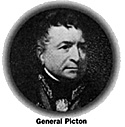 Leith occupied an extended line from the St. Paulo - Palmases road to the south of the San
Antonio de Cantaro Pass. The far right of Leith's position was held by the three British regiments of Barnes's Brigade. Like Hill, Leith was ordered to move to his left to support the 3rd Division, which was next in line, if the 5th Division was not attacked.
Leith occupied an extended line from the St. Paulo - Palmases road to the south of the San
Antonio de Cantaro Pass. The far right of Leith's position was held by the three British regiments of Barnes's Brigade. Like Hill, Leith was ordered to move to his left to support the 3rd Division, which was next in line, if the 5th Division was not attacked.
Picton's 3rd Division was stationed around the pass on the San Antonio de Cantaro to Palhieros road. At the Pass itself was Mackinnon's British brigade, with Champlemond' Portuguese brigade in support on either flank. Some 1,500 yards to the north was Picton's second British brigade, commanded by Lightbourne.
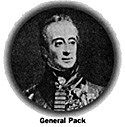 North of Picton's position the ridge rises sharply to its highest point. Along this almost
impregnable ground with its precipitous front were ranged the three British brigades of the 1st
Division. From this high ground the ridge falls abruptly down to the eastern side of the convent
walls. Here Pack's Portuguese brigade was posted, with the wall to its back and a very steep
slope in its front.
North of Picton's position the ridge rises sharply to its highest point. Along this almost
impregnable ground with its precipitous front were ranged the three British brigades of the 1st
Division. From this high ground the ridge falls abruptly down to the eastern side of the convent
walls. Here Pack's Portuguese brigade was posted, with the wall to its back and a very steep
slope in its front.
Opposite the northern wall of the convent ran the Coimbra high road. This vital pass was held by the Light Division supported by Coleman's Portuguese brigade.
Along a curve of the highroad were the 43rd and 52nd Regiments of the Light Division. The
road was cut through the hillside at this point and these two regiments were hidden from the road, but they only had to advance a few feet to reach the skyline from where they could command the slope reaching down to the tiny village of Sula which was situated halfway down the hillside. In the village, Craufurd had placed the 3rd Cacadores, with his other Portuguese battalion and the 95th Rifles strung out on the slopes above.
Far above the Light Division, and adjacent to the northern wall of the convent, stood the
battalions of the King's German Legion, and 200 yards to the southwest was Campbell's
Portuguese brigade. These two brigades constituted the general reserve of the army.
To the north of Campbell's Portuguese, and forming the north-eastern limit of Wellington's line, was Cole's 4th Division. Cole's Portuguese brigade was pushed forward on the left with the
two British brigades at the head of the slope. The ridge here was not very high but the ground was steep.
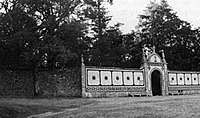 At right, the Sula gate of the convent enclosure. Some of the loopholes are still in the adjacent wall (to the left)
At right, the Sula gate of the convent enclosure. Some of the loopholes are still in the adjacent wall (to the left)
The wall of the convent enclosure was an integral part of Wellington's defences. An opening
was made near Pakenham's Brigade of the 1st Division, and lower down at the Porta da Sula the
entrance was covered with abattis. Staging was erected inside the wall for infantry to fire from over the wall on either side of the entrance and the wall itself was lowered considerably and loopholes were made at various points.
Seventy-six guns were distributed along the mountain. Ross's troop of the RHA was with
Craufurd on the Mortagoa-Coimbra highway. For over half a mile this road overhangs the
precipitous sides of a deep ravine on its left whilst on its right at this point was a dense pinewood. The effect of these features was to create a narrow defile and Ross's guns were able to enfilade this defile from across the ravine. These guns had been placed in a sort of natural redoubt formed by a semicircular row of boulders with gaps inbetween.
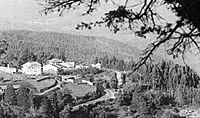 At left, the center of the photo is the northern end of the broad central part of the serra where the two squadrons of the 4th Dragoons were posted. In the right foreground can be seen the village of Sula.
At left, the center of the photo is the northern end of the broad central part of the serra where the two squadrons of the 4th Dragoons were posted. In the right foreground can be seen the village of Sula.
Some of Ross's guns bore down on the village of Sula on the lower slope below and the others were aimed across the ravine to the high road. The other troop of the RA, commanded by Captain Bull, was posted with the 4th Division.
Of the field batteries, two Portuguese brigades ( twelve guns ) under Dickson, were with the 2nd Division, another two Portuguese brigades were with the 5th Division. At the San Antonio pass were twelve guns under Major Arentschildt. With the 1st Division were Lawson's and Rettberg's batteries, and Thompson's six guns were with Lightburne.
Along the southeastern wall of the convent were massed together the brigades of Cleeves
and Passos. These twelve guns overlooked the slope above Moura and enfiladed the Coimbra
highway.
Wellington also posted two squadrons of the 4th Dragoons on the broad central top of the
mountain "in case of anything forcing its way through the Brigade of Pack, will fall
upon it in flank," wrote a Portuguese staff officer, "for the Ground is so favourable that a
charge executed here will probably destroy whatever is in its way."
Because the position was so extended, and because Wellington could not predict with absolute certainty where the French attack, or attacks, would fall, he had to spread his forces along almost the entire nine miles of mountaintop. Yet he concentrated most of his artillery --
the least mobile of the military arms -- at the most likely points of attack i.e. along the Moura to Coimbra highway, and the San Antonio de Cantaro Palhieros pass.
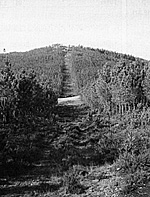 At right, a section of the track which enabled the defending troops to transfer laterally along the ridge.
At right, a section of the track which enabled the defending troops to transfer laterally along the ridge.
Wellington had arrived at Busaco at least five days ahead of the advancing French army and
he had ample time to plan his defences. His engineers had broken up all the roads approaching the mountain so as to restrict the movements of the French artillery, and they had barricaded the San Antonio - Palheiros road with abattis and littered it with large boulders. Wellington had also turned the convent into a powerful strong-hold, just as he would do five years later at Waterloo with the chateau of Hougoumont.
British Order of Battle
1st INFANTRY DIVISION
(Spencer)
| Stopford's Brigade | Officers | Men |
|---|
Coldstream & Scots Guards
1 Co. 5th/60th Foot | 52 | 1,632 |
| Blantytre's Brigade |
|---|
2nd/24th, 2nd/42nd
1st and 2nd/61st
1 Co. 5th/60th Foot | 92 | 1,424 |
| Lowe's Brigade |
|---|
1st, 2nd, 5th & 7th Line
detachment 1st and 2nd Lights Btns. KGL | 119 | 1,942 |
| Pakenham's Brigade |
|---|
| 1st/17th, 1st/79th Foot | 64 | 1,728 |
| TOTAL | 327 | 6,726 |
|---|
2nd INFANTRY DIVISION
(Hill)
| Stewart's Brigade | Officers | Men |
|---|
1st/3rd, 2nd/31st, 2nd/48th
2nd/66th, 1 Co. 5th/60th Foot
| 117 | 2,130 |
| Inglis' Brigade |
|---|
29th, 1st/48th, 1st/57th
1 Co. 5th/60th Foot
| 92 | 1,726 |
| Craufurd's Brigade |
|---|
2nd/28th, 2nd/34th, 2nd/39th
1 Co. 5th/60th Foot | 97 | 1,575 |
Hamilton's Portuguese Division
(Attached to 2nd Division) |
|---|
| Campbell's Brigade |
|---|
| 4th and 10th Line (two bttns each) | all ranks | 2,250 |
| Fonseca's Brigade |
|---|
| 2nd and 14th Line (two bttns each) | all ranks | 2,690 |
| TOTAL | 306 | 10,371 |
|---|
3rd INFANTRY DIVISION
(Picton)
| Mackinnon's Brigade | Officers | Men |
|---|
| 1st/45, 1st/74th, 1st/88th Foot | 113 | 1,695 |
| Lightbourne's Brigade |
|---|
2nd/5th, 2nd/83rd
3 Co. 5th/60th Foot | 90 | 1,070 |
| Champlemond's Portuguese Brigade |
|---|
| 9th and 21st Line (two bttns each) | all ranks | 1,757 |
| TOTAL | 203 | 4,540 |
|---|
4th INFANTRY DIVISION
(Cole)
| Campbell's Brigade | Officers | Men |
|---|
2nd/7th, 1st/11th, 2nd/53rd
1 Co. 5th/60th Foot | 98 | 2,011 |
| Kemmis' Brigade |
|---|
3rd/27th, 1st/40th, 97th
1 Co. 5th/60th Foot | 113 | 2,335 |
| Collin's Portuguese Brigade |
|---|
| 11th & 23rd Line (two bttns each) | all ranks | 2,834 |
| TOTAL | 211 | 7,189 |
|---|
5th INFANTRY DIVISION
(Leith)
| Barne's Brigade | Officers | Men |
|---|
| 3rd/1st,1st/9th, 2nd/38th Foot | 94 | 1,785 |
| Spry's Portuguese Brigade |
|---|
3rd and 15th Line (two bttns each)
Thomar Militia | all ranks | 2,619 |
| Lusitanian Legion |
|---|
| (3 bttns) and 8th Line (two bttns each) | all ranks | 2,807 |
| TOTAL | 306 | 10,371 |
|---|
Light INFANTRY DIVISION
(Craufurd)
| Beckwith's Brigade | Officers | Men |
|---|
1st/43rd, 1st/95th (four cos.)
3rd Portuguese Cacadores | 52 | 1,844 |
| Barclay's Brigade |
|---|
1st/52nd, 1st/95th (four cos.)
1st Portuguese Cacadores | 41 | 1,850 |
| TOTAL | 93 | 3,694 |
|---|
Independent Portuguese Brigades
| 1st Brigade (Pack) | Officers | Men |
|---|
1st and 16th Line (two bttns each)
4th Cacadores | all ranks | 2,769 |
| 5th Brigade (A. Campbell) |
|---|
6th and 18th Line (two bttns each)
6th Cacadores | all ranks | 3,249 |
| 6th Brigade (Coleman) |
|---|
7th and 19th Line (two bttns each)
2nd Cacadores | all ranks | 2,345 |
| TOTAL | 8,363 |
|---|
CAVALRY
| 4th Dragoons (2 sqdrns) | Officers | Men |
|---|
| Rest of Allied Cavalry did not take part in the battle | 15 | 195 |
ARTILLERY
| Unit | Guns |
|---|
| 'A' Troop R.H.A. (Ross) | 6 |
| 'I' Troop R.H.A. (Bull) | 6 |
| 6th Co. 7th Btn R.F.A. (Thompson) | 6 |
| 7th Co. 8th Btn R.F.A. (Lawson) | 6 |
| 2nd Co. KGLA (von Rettberg) | 6 |
| 4th Co. KGLA (Cleevers) | 6 |
| 1st Reg. Portuguese Art. (Dickson) | 12 |
| 2nd Reg. Portuguese Art. (Arentschildt) | 12 |
| 4th Reg. Portuguese Art. (de Sousa) | 6 |
| Undetermined Portuguese Art. (Dickson) | 12 |
Historical Background
The Battlefield
The Attackers (and OOB)
The Battle
Back to Battlefields Vol. 1 Issue 4 Table of Contents
© Copyright 1996 by Partizan Press.
This article appears in MagWeb (Magazine Web) on the Internet World Wide Web.
Other military history articles and gaming articles are available at http://www.magweb.com
|
 At right, a view toward the San Antonio pass and the far right of the Anglo-Portuguese line. It is easy to see from this view why Massena considered the ridge too extended for Wellington to defend successfully.
At right, a view toward the San Antonio pass and the far right of the Anglo-Portuguese line. It is easy to see from this view why Massena considered the ridge too extended for Wellington to defend successfully.
 Leith occupied an extended line from the St. Paulo - Palmases road to the south of the San
Antonio de Cantaro Pass. The far right of Leith's position was held by the three British regiments of Barnes's Brigade. Like Hill, Leith was ordered to move to his left to support the 3rd Division, which was next in line, if the 5th Division was not attacked.
Leith occupied an extended line from the St. Paulo - Palmases road to the south of the San
Antonio de Cantaro Pass. The far right of Leith's position was held by the three British regiments of Barnes's Brigade. Like Hill, Leith was ordered to move to his left to support the 3rd Division, which was next in line, if the 5th Division was not attacked.
 North of Picton's position the ridge rises sharply to its highest point. Along this almost
impregnable ground with its precipitous front were ranged the three British brigades of the 1st
Division. From this high ground the ridge falls abruptly down to the eastern side of the convent
walls. Here Pack's Portuguese brigade was posted, with the wall to its back and a very steep
slope in its front.
North of Picton's position the ridge rises sharply to its highest point. Along this almost
impregnable ground with its precipitous front were ranged the three British brigades of the 1st
Division. From this high ground the ridge falls abruptly down to the eastern side of the convent
walls. Here Pack's Portuguese brigade was posted, with the wall to its back and a very steep
slope in its front.
 At right, the Sula gate of the convent enclosure. Some of the loopholes are still in the adjacent wall (to the left)
At right, the Sula gate of the convent enclosure. Some of the loopholes are still in the adjacent wall (to the left)
 At left, the center of the photo is the northern end of the broad central part of the serra where the two squadrons of the 4th Dragoons were posted. In the right foreground can be seen the village of Sula.
At left, the center of the photo is the northern end of the broad central part of the serra where the two squadrons of the 4th Dragoons were posted. In the right foreground can be seen the village of Sula.
 At right, a section of the track which enabled the defending troops to transfer laterally along the ridge.
At right, a section of the track which enabled the defending troops to transfer laterally along the ridge.